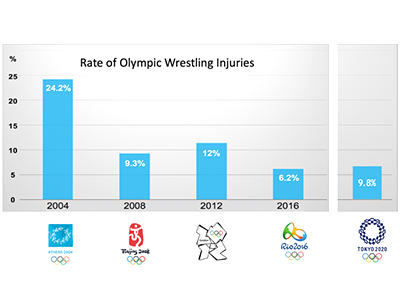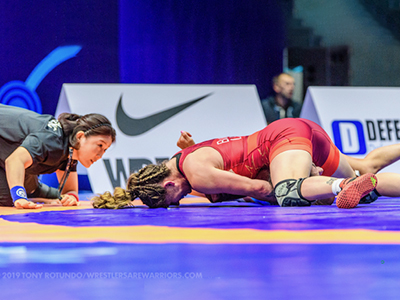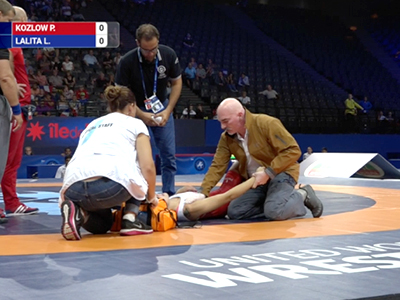
New research-based approaches target musculoskeletal injury prevention in high-level competition.
A comprehensive injury prevention initiative developed by Vancouver Coastal Health Research Institute researcher Dr. Babak Shadgan is revolutionizing safety in competitions of Olympic styles of wrestling. The chief medical officer of wrestling competitions at six Olympic Games, Shadgan’s work contributed to safety improvements that helped cut the total wrestling competition injury rate of 24.2 per cent at the 2004 Olympics in Athens, Greece, down to 6.2 per cent in the 2016 Olympics in Rio de Janeiro, Brazil.
“An important change that we made to wrestling regulations for the safety of wrestlers was banning dangerous headlock manoeuvres that could cause neck and spine injuries,” says Shadgan. “Since banning this technique, the rate of neck and spine injuries in Olympic wrestling has significantly dropped over the past few years.”
"From Athens to Rio, we have seen a remarkable reduction in injuries in Olympic wrestling competitions and training exercises.”
Shadgan and his team have been collecting data on Olympic wrestling injuries since 2004, recording wrestling matches and reviewing video-recorded footage to note how, when and what injuries occur during competitions.

A recent paper led by Shadgan and published in the British Journal of Sports Medicine evaluated and compared wrestling injury rates from the 2016 Rio and 2020/1 Tokyo Olympic Games to track and categorize wrestling injuries.

Their investigations found that most wrestler injuries were mild skin lacerations and bruises to the head and face regions that occurred while competitors were in standing positions during the 1/8-final round that takes place before the quarter-finals. While the injury rate at the Rio and Tokyo Games was relatively similar, Shadgan and his team’s review of video coverage of wrestling events revealed a significant pattern.
“We realized that there were many occasions in which referees could have identified that one competitor was applying too much force, particularly overly twisting or stretching a joint,” notes Shadgan. “Had the referee stopped the play, they could have prevented a shoulder dislocation, knee injury, ankle injury or finger fracture, for example.”
Protecting athletes with Pro-Active Referees, and strength and stretch training
To better equip referees to identify and stop dangerous actions during a wrestling match, Shadgan and his team developed a ‘Pro-Active Referee’ training course and webinar for Olympic-level referees. So far, 80 Olympic-level referees have undergone the training, 50 of which were selected to officiate the wrestling competitions at the 2024 Paris Olympics.
"For the Paris Olympics, we now have a group of highly trained referees who will oversee wrestling matches.”
With insights from sports physicians, physiotherapists and other experienced sports medicine staff from around the world, Shadgan and his team are developing a series of stretches and strengthening exercises that athletes can perform to protect themselves from a severe joint injury, such as a shoulder or knee dislocation.
“A proactive and well-trained referee is one part of the equation, but athletes can also take steps to reduce their risk of injury by strengthening around the joint and performing stretching exercises that can better protect them while competing,” Shadgan explains.
Over-twisting resulted in four severe joint dislocations at the Rio and Tokyo Games, all of which occurred while wrestlers were in the par terre position — when one athlete is placed with their hands and knees on the mat while their opponent kneels beside them with their hands on the bottom athlete’s back.

Joint dislocations are of particular concern to athletes because the stretching that occurs in the ligaments of the joint can destabilise it for quite some time. A dislocation during an Olympic match takes the injured athlete out of the Games. Elite-level competition may be off the table for months, years and sometimes forever due to the risk of repeat dislocations, notes Shadgan.
“Prevention is paramount,” he says. “Due to the severe consequences of a joint dislocation for an athlete, particular care should be taken to analyse the mechanisms of this type of injury and prevent it.”
“Our goal is to ensure that athletes can perform at their best, free from unnecessary risks.”



